originally posted at https://canmom.tumblr.com/post/709449...
…Bard Brid? Sorry, the line’s not very clear here. Say again…
Oh, Brad Bird?
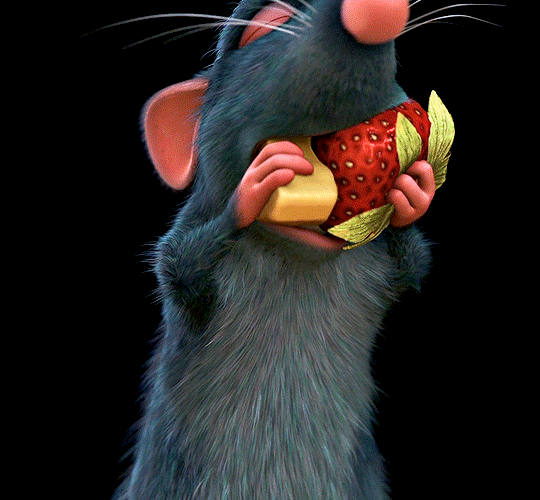
OK, so. Imagine there’s a really dad-like guy who directs movies. Someone for a lot of nostalgia for his childhood during which, Cold War not withstanding, he was impassioned by witnessing The Jungle Book (not unlike a certain Richard Williams) and encouraged by supportive parents to pursue animation. And it went well. Really well. Our boy Brad got an ‘unprecedented’ internship at Disney with Milt Kahl(!) off the back of his film The Tortoise and the Hare, had a chill time at high school, then went to CalArts on scholarship where he studied alongside John Lasseter (keep an eye on him. not just because he might sexually assault somebody but also because he’ll be in this story later), Tim Burton and Henry Selick.
In short, about the most direct and uncomplicated route into animation you can imagine.
Brad Bird joined Disney (their investment paying off) in 1978, working on films like The Fox and the Hound and The Black Cauldron, but soon clashed with the studio heads who he judged not to be upholding principles he believed Disney represented. (He would be vindicated in a way by Don Bluth throwing down the gauntlet a few years later and kicking off the ‘Disney Renaissance’.) One of his last contributions must have been to The Brave Little Toaster, where he worked alongside the future founders of Pixar.
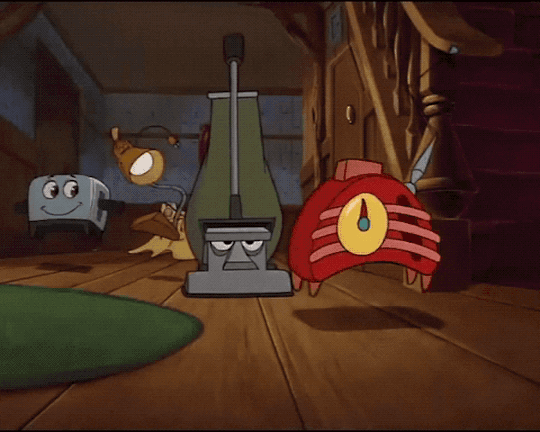
There followed a few years in which he moved to the SF Bay Area (perhaps not so gentrified back then(?) but Bird definitely had money), pitching projects left and right. One of his big passions was to adapt the comic book The Spirit. Mostly he tried experiments that didn’t pan out, like making a CG film at Lucasfilm with Ed Catmull, later founder of Pixar. He worked on The Plague Dogs (AN 86) until he got fired again.
Nevertheless, his reel of hypothetical films did catch the eye of Steven Spielberg, who absorbed Bird into his company Amblin Entertainment in order to expand his short film The Family Dog, co-created with Tim Burton, into an episode of the anthology series Amazing Stories. (Family Dog would later spawn a disastrous spin-off series in 1993, but by this point Bird had moved on). I think it’s worth noting this one because it gives a sense of what sort of original ideas Bird is working with: a dysfunctional suburban family as seen through the eyes of their dog. ‘Dysfunctional suburban family’ would be the centre of… almost every single one of Bird’s works since.
Bird continued to work under Spielberg’s wing, still clashing with execs; he got straight-married in this time to film editor Elizabeth Canney. Things seemed to be going well enough, despite his frustrations - until his sister Susan was killed in a murder-suicide by her estranged husband. This understandably fucked with him pretty hard. After a few years of depression he recovered, enough to take an invitation to work on The Simpsons in 1989 after Matt Groening was impressed by the cinematography in Family Dog. (Seriously he’s connected to just about everyone in the animation industry!) He continued on the Simpsons throughout the early 90s, working part-time to ‘oversee the script-to-animation pipeline’ and introduce this same filmic sensibility, as well as contributing to other animated sitcoms like The Critic and King of the Hill.
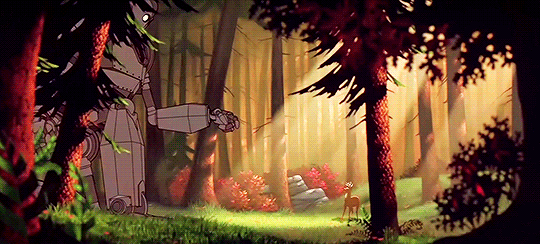
Let’s fast forward to the end of the 90s. As we’ve discussed… many times on this webbed site, this is when the steam of the ‘Disney Renaissance’ was about to run out, and the new CG era was about to begin. Our boy Brad, meanwhile, is struggling trying to juggle being a Dad™ with spending all his time making animated films. Which leads to Brad writing… a story about a suburban family strained by one of them being a superhero, yeah.
But Brad wouldn’t get to make this film just yet. Instead, his successful pitch was something called Ray Gunn, a scifi story about a detect in an Art-Deco retrofuturistic world. This movie also did not get made… but it’s because Warner bought up the studio Turner that was making it, and shut down Ray Gunn. Instead, they offered Bird a different animated film with a nostalgic bent, adapting childrens’ book The Iron Man by Ted Hughes, which was in its turn written to help his children cope with the death of his wife Sylvia Plath (yeah that Sylvia Plath!). Bird liked the pacifist themes of the novel, but while the children’s book has the feeling of a parable, he gave it a concrete setting in the 50s, and centered the story on the paranoia of the Cold War, seen from the point of view of an innocent boy.
So with this first movie we see start to see the major preoccupations of Brad Bird come into play (though he did not write the screenplay in this case). The Iron Giant comes in the middle of a brief handful of traditionally animated films made by Warner to ride on the coattails of Disney; the others include Space Jam and Osmosis Jones. They were by and large not very successful; The Iron Giant was the one critical success but failed for blah blah marketing y’know reasons. Like most of Bird’s films, the core relationship is a father [figure]-son one, in this case beatnik artist Dean who lives in a junkyard and ends up becoming surrogate father to nine-year-old protagonist Hogarth.
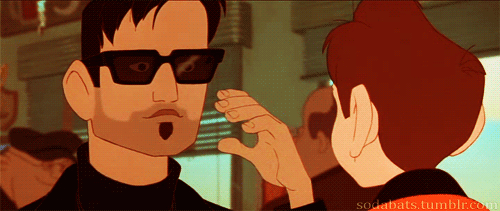
The themes of the film are pretty on the nose: in an idyllic American small town (Bird explicitly referred to Norman Rockwell and sitcom character Ward Cleaver) masking severe paranoia falls a harmless alien robot. It’s viewed as a threat by everyone but the social outcast and the child. The military get called in, gung-ho to throw around their toys; by the time the townspeople figure out that they’ve been huge cunts, a missile is in the air. What saves everyone is the fact that our nine-year-old protagonist has gone to the effort of teaching the Giant good old American values, so it goes and intercepts the missile in a heroic sacrifice… undercut with a final hint that it can regenerate. In fact Bird originally planned an ending where full scale war breaks out between the US and USSR, but ultimately this was softened.
What sells it is charming character animation. The production seems to be the opposite of most animated film stories: meticulously planned, prevised and storyboarded, while making effective use of cel-shaded CG for vehicles and mecha scenes, putting it among the first works to experiment in that direction. In another anime-like touch, the animation of the film was divided up by scene rather than by character.
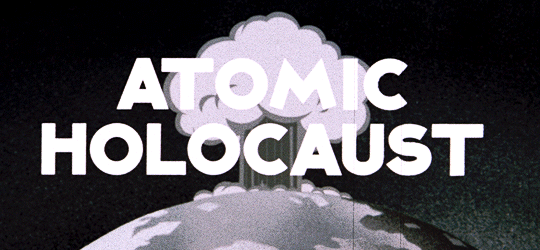
And, within the American full animation tradition, it’s probably one of the only films to address the Cold War at all. Of course there are others from other countries! When The Wind Blows is probably the most direct; anime is rarely directly about the Cold War (the Future War 198X controversy excepted) but it’s implicit in most works that deal with sci-fi and military themes such as Akira. And in modern times, now that it’s History and serious animated dramas are more accepted, you get films like Funan about the Cambodian genocide. In the USSR… it’s complicated.
But in America… while animation studios were recruited en masse to produce WWII propaganda, for the most part animated films from the 50s through to the 80s don’t really touch on the war. They adopt mythological past settings, or tell stories closer to home. Perhaps by the time of The Iron Giant, with the war over, and the specific setting now 50 years in the past, it was considered safe enough.
The characters of Bird’s film are very much archetypal. It’s kind of a fable about the Cold War, and in the final edit of the script, a reassuring one. The ‘illusion of life’ animation techniques are used to imbue each character with enough charm and specificity but they are largely defined by their roles. I’m not saying this to criticise; this is precisely the model of film that American animation specialises in and it uses it to very good effect. Ultimately though because it’s a fable, you can only take so much from it.
Despite the commercial failure of The Iron Giant, it did finally give Brad some clout as a director. A certain John Lasseter to a new studio that was making serious waves in animation… yeah, you know them, it’s Pixar. I wrote about early Pixar back on Animation Night 75, so go check that out if you like.
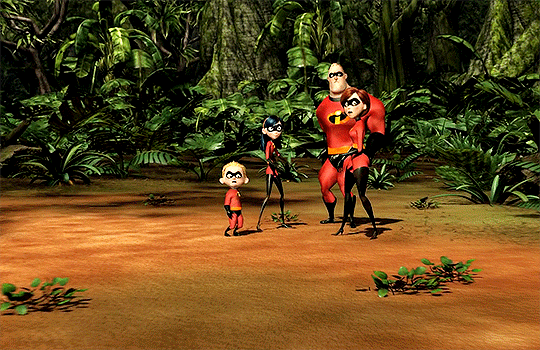
At Pixar, Bird ended up directing the studio’s sixth film, finally getting a chance to follow up on his pitch for The Incredibles which features… that’s right… a suburban family with a beleaguered father in a setting designed to nostalgically reference a mid-20th-century American aesthetic. Mmm.
By this time, Pixar movies had started to establish a formula. The characters would be some kind of high concept centering on characters like toys, bugs, monsters or fish that wouldn’t face the limits of rendering humans. Usually they would center on a duo of male characters who would start off at odds and but gradually build a bond over the course of the film. They’d be suitable for kids but have enough comedy to amuse adults. There would be a villain to overcome, and a wider sphere of quirky buddies to support the main duo. Women would be almost nonexistent. At this time, it seemed that Pixar could do absolutely no wrong; their films were basically always hits.
But even so, I remember when The Incredibles came out. It hit the nerd sphere like a bomb. I remember all the memes about Edna Mode (voiced Brad Bird) shouting ‘no capes!’; I also remember the articles that argued that the film was in fact Objectivist propaganda.
Looking back, it’s hard to entirely disagree with them! The thrust of The Incredibles is that an ungrateful public rejects the special superheroes, leading to an end to their romantic days of vanquishing evil and staging dramatic fights on top of trains; now they’re all caught up in the banality of the capitalism. Bob, aka ‘Mr Incredible’, works in a miserable cubicle as an insurance salesman; Helen aka ‘Elastigirl’ is an exhausted suburban housewife trying to rein in somewhat estranged superpowered teenagers. The pencil-necked bureaucrats of Society, you see, have denied them the chance to exercise their special abilities as they did in the romantic past.
But lo! There is a new supervillain after all; it is Syndrome, once a starry-eyed young superhero, who after a rejection by Mr Incredible, came up with a plan to create a high-tech scheme to sell gadgets that would make just about anyone be able to use superpowers - even if, the arc words declare, ‘if everyone is special, no-one is’, a sentiment that basically goes unexamined further. However, his plan to stage a superhero battle to sell these gadgets backfires resulting in an out of control robot. Luckily, the Incredible family have been united over the course of their adventures and can defeat the robot, society reevaluates the superhero issue, and the captains of industry heroes can assume their proper roles of being naturally better than everyone.
It is, looking back with adult eyes, a very strange narrative to be pushing; it’s possible to see the feelings that Bird must have put into it but damn lmao dude’s got some shit to examine. But as a film it’s technically pretty much impeccable, with memorable sequences that got memed about as much as any animated film from the 2000s. It opened ‘families amirite fellas’ as an avenue for Pixar to tell stories about, which they’d dig into much further later with films like Inside Out.
But I won’t spare too any more words on The Incredibles, since I’m not actually planning to show it tonight. No, the other film of Bird’s I’m planning on showing is…
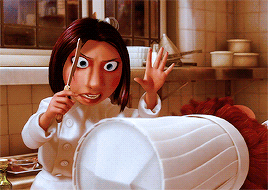
Ratatouille! A film whose influence lasted so long that you’ll get an extended parody even in 2022′s Everything Everywhere All At Once. As far as Pixar high concepts go it’s pretty up there, centering on a food-loving rat Remy who befriends a chef and hatches a scheme where he will give instructions by tugging on his hair while hiding under a chef’s hat. This concept was not due to Bird but to Jan Pinkava, director of Geri’s Game, who had developed the film for years; Bird was pulled in to attempt to salvage what Pixar saw as a hopelessly mired production. Bird, with some reticence, took the established design work, but rewrote the script into something that better fit his tastes in filmmaking. Pinkava for his part refused to comment, but left Pixar not much later.
So the Brad Bird angle enters in the secondary plot, with Remy’s relationship with his dad who doesn’t understand his artistic passion for food. The story is probably what you’d expect given these elements! ‘Probably’ because… I actually haven’t seen this movie, it’s like the one major gap in my knowledge of ‘classic’ Pixar films.
Since Ratatouillie, Bird departed animation and started directing live-action films, including an episode of Mission Impossible that breaks the formula (unless it’s got some kind of dad arc I don’t know about), and Tomorrowland which gets back on the 50s nostalgia train. I haven’t seen any of them so I can’t really comment too much except to say that it sounds like Tomorrowland doubles down harder on the vague Objectivism angle lmao.
But rather than an explicit philosophical conviction, which Brad Bird the self-described ‘centrist’ doesn’t particularly seem to have, it seems more that it’s just a channeling of not entirely examined frustrations about his difficult time getting established as a filmmaker. Bird, it seems, grew up basically being told he was a one of a kind animation genius, and entered the animation industry with a lot of romantic expectations which were frustrated by its reality. It’s easy to read his films as mostly being about how people didn’t understand clever Brad Bird.
Bird is a bit of an odd case in another way. Like basically all animators he rails against the ‘animation is for children’ stereotype of the medium that just doesn’t seem to break, yet his films are very much about archetypal characters with very clearly defined, abstracted arcs. Perhaps that’s just what he’s able to make. But he doesn’t seem to be interested in pushing the envelope anywhere particularly weird or discomforting. Beyond his ambition to bring live action cinematography in to animation, his ‘superpower’, once he got to exercise it, seems to be that he’s very good at planning. His scripts are tightly focused, his productions are on schedule, and he’s the guy you call in when old Jan isn’t finishing his movie on time.
Still, all these criticisms aside, he’s one of the major influences on the subsequent decades of CG films, and his films are consistently very solid. So if you’d like to join me - with apologies for the late start - we’ll be watching The Iron Giant and Ratatouille over at twitch.tv/canmom. Hope to see ya there, films start in about 15 minutes!
Comments